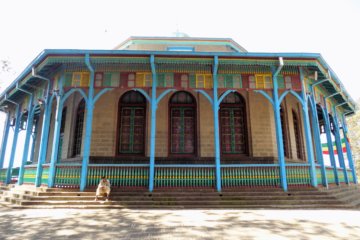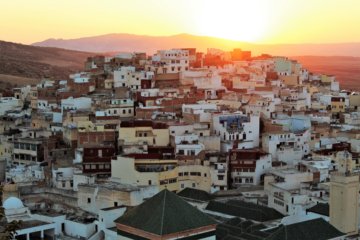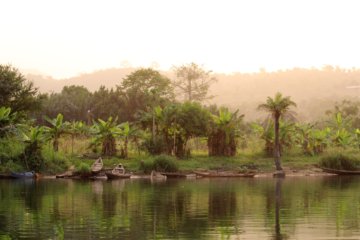We were struck by how quiet the roads were (Kebba pointed out that this was only because it was Saturday and was not the norm) and how colourful everything was. Now that we’ve been here a little while, I realise that most of the colour we notice comes from the fabulous dresses worn by the women. These outfits brighten the most mundane situation. Clothes in drab grey or brown just don’t seem to exist here!
| A Gambian woman with a quirky taste in hats! |
Gambia is the smallest country on mainland Africa and has a population of only 1.8 million. It is also one of the poorest with a third of people living on less than $1.25 a day. These facts clearly cause problems, some of which I will address in another post, but, generally, people seem open, friendly, welcoming and happy.
Looking at a map, you see that, apart from a short Atlantic coast, The Gambia is surrounded on all sides by Senegal and, thanks to the whims of British and French officials in the nineteenth century, has one of the most ludicrous shapes for a country I’ve ever seen! The agreement drawn up by the two nations gave the UK control of a large part of the River Gambia and a sliver of land either side of it, resulting in this, a country which is less than 30 miles wide at its widest point:
Gambia gained its independence in 1965, after almost 200 years of British colonial rule. Fifty years on, The Gambia strikes the visitor as a proud young nation. The flag, which was designed by Louis Thomasi, has significance for all Gambians and is displayed everywhere. The red stripe represents the sun, the
white is for peace, the blue stands for the River Gambia and the green signifies agriculture, the mainstay of the Gambian economy.
The national anthem, based on a traditional Mandinka folk song, and written and composed by British couple Virginia and Jeremy Howe, is sung regularly and the words displayed on walls all over the place. This photo was taken in John Raymond’s Beach Bar on Kotu Beach:
The people of The Gambia belong to different ethnic groups, the largest being the Mandinka and Wolof tribes, but now they all live harmoniously together. The official language of the country is English and the vast majority of schoolchildren are taught in English (the others are taught in Arabic), but almost all the population converse in their own languages at home and in social and work situations.
When it comes to religion, 85% or more of Gambians are Muslim and the remainder are Christian, but both religions happily coexist. There is no stigma attached to marrying outside of your religion and, in schools, Christian and Islamic holidays are given equal importance.
Overall, our first impressions of The Gambia have been positive – friendly, happy people who lend credence to the nation’s nickname – ‘The Land of Smiles’.
Join our mailing list

Sign up to receive our monthly newsletter. Keep up with what we're doing and be the first to receive special offers and insider tips.













